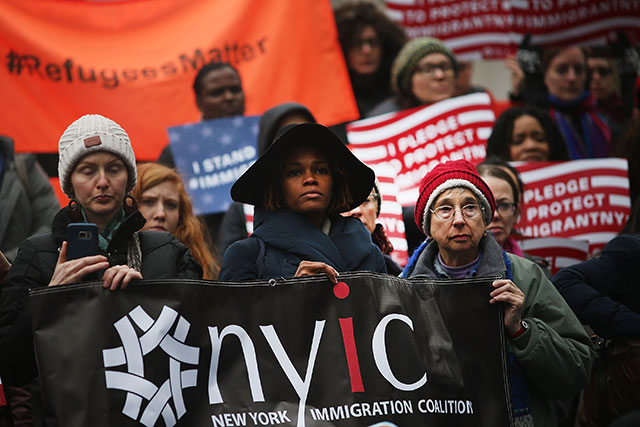
 Area Muslims and local immigration activists participate in a prayer and rally against President Donald Trump’s immigration policies on January 27, 2017 in New York City. The Freedom Cities campaign expands on the sanctuary movement to create a framework for cities to offer protection to all oppressed people in the United States. (Photo: Spencer Platt / Getty Images)
Area Muslims and local immigration activists participate in a prayer and rally against President Donald Trump’s immigration policies on January 27, 2017 in New York City. The Freedom Cities campaign expands on the sanctuary movement to create a framework for cities to offer protection to all oppressed people in the United States. (Photo: Spencer Platt / Getty Images)
This summer will mark the third anniversary of the death of Eric Garner, a New York man who was killed by police officers outside of a neighborhood convenience store in Staten Island (he was suspected of illegally selling loose cigarettes). Garner’s death is one of many that has raised Americans’ concerns about the increasing number of Black men, women, and children killed by US law enforcement officers.
At only 13 percent of the US population, African Americans are killed by police, incarcerated, live in poverty, and have poor health at higher rates than White Americans, who make up the majority populace. These numbers and conditions are much the same as those attributed to other disenfranchised citizens, including Latino Americans, who are 17 percent of the population.
Contemporary movements continue to address these tragedies.
Black Lives Matter is campaigning against the criminal justice system, calling for an end to racial profiling, police brutality and killings, and for officers to be held accountable for their actions. The Movement for Black Lives policy platform, released last summer, is demanding the reallocation of resources to improve and protect the lives of all Black people in the United States — citizens, immigrants, cis, trans, queer, gender nonconforming, and differently-abled. And, in response to the Trump administration’s deportation machine, cities are looking for ways to create safe spaces for immigrants and refugees in the sanctuary movement.
Earlier this year, a campaign was launched to extend these ideas to all marginalized groups that need safety. Named Freedom Cities, this campaign expands on the sanctuary movement to create a framework for cities to offer protection to all oppressed people in the United States.
Marginalized US Citizens Need Protection, Too
Historically, sanctuary cities or states have existed since slavery, when certain areas were identified as safe zones for enslaved Africans who had escaped their owners’ plantations. But the term became more common in the 1980s, under the Reagan administration, when protests grew against federal immigration laws that prevented Central American refugees from gaining asylum in the United States. Pastors designated their churches as sanctuaries for the undocumented immigrants, who were poor and homeless. Today, this concept — sanctuary as a strategy in which cities refuse to invest local resources in immigration enforcement — does not go far enough, some say.
On Inauguration Day, a coalition of New York City-based organizations held a mass demonstration outside the Trump Hotel, demanding resources for oppressed communities not only to survive, but also to thrive. The coalition wants sanctuary to include the provision of safety for citizens who live in danger daily. Members ask, “Where is the sanctuary when ICE is setting up checkpoints and conducting raids in our communities? Where is the sanctuary for folks impacted by the War on Drugs, racial profiling, or police violence? Where is the sanctuary for people with convictions?” Cities, towns, and neighborhoods need to be safe for low-wage workers, Black, Latino, and Muslim Americans — as well as immigrants — they say.
Enlace, an international multicultural alliance of low-wage worker centers, unions, and community groups in NYC, is a member of the New York Worker Center Federation, the coalition that is organizing Freedom Cities. Enlace Executive Director Daniel Carrillo says the group is shifting how safety is defined.
“The way that Trump and past [presidential] administrations defined it was more prisons, more police in the streets, more deportation and detention,” says Carrillo. The Freedom Cities campaign seeks to change that and look at what safety means for whole communities, he explains. “Because all those measures don’t create safety actually. They create more of a police state for us.”
The goal of Freedom Cities, he adds, is for all people to be safe and free from the threat of physical violence and economic disadvantage: immigrants — documented or undocumented — people with criminal convictions, workers, gender nonconforming folks, the poor, and all people of color.
Freedom Cities Strategy and Framework
Days after the 2016 presidential election, the plan for Freedom Cities emerged at a meeting run by NYWCF, a multicultural coalition of organizations for the rights of workers, immigrants, and people of color. The coalition wasn’t just responding to the election. It sought to address the violence and oppression against marginalized groups that had been taking place for years. In particular, coalition members looked to the deaths of Garner and Delfino Velazquez — a New York construction worker who in November 2014 was killed on the job because of contractor negligence — and the addition of 1,300 NYPD officers the following year. While city officials proclaimed more police officers meant safer neighborhoods, these activists disagreed.
So they have developed the Freedom Cities campaign to create safer communities. The demands in the framework are inspired by various social justice organizations’ campaigns over the past decade. Members studied sanctuary city tenets and the Movement for Black Lives policy platform. The Freedom Cities campaign builds on these movements and applies their core principles to issues of immigrant rights, police brutality, gender justice, and state violence. The result is a six-point platform for what the campaign will work toward. This includes:
1. Ending Criminalization
Divest from policing and militarization and invest in programs that produce real public safety, such as mental health services and restorative practices. This includes campaigns to end practices such as broken windows policing.
2. Economic Justice and Workers Rights
Create labor protections, jobs, and employment opportunities for workers. Engage in efforts to combat discrimination, increase wages, and protect the right to organize.
3. Investment in People and Planet
Divert resources toward communities’ basic needs, including housing, education, health, (nutritious) food, and safety net programs. Protect our communities from environmental injustices.
4. Community Control
Gain real control of the institutions that people interact with daily, including police and other public agencies.
5. Community Defense
Establish systems of self-defense in neighborhoods to protect rights and dignity.
6. Global Justice
Link national struggles for liberation with others across the world. Recognize that our identities and migration histories connect us globally, and that we are part of an international movement of those who believe that everybody deserves safety and freedom.
Organizers say the action plans are still in development. However, one tactic that Freedom Cities is looking to engage in initially and build upon is Hate Free Zones.
Hate Free Zones, Peace Zones for Life
A model for Hate Free Zones currently exists in Detroit under the designation Peace Zones for Life. For the past five years, Peace Zones has worked to address community violence and interpersonal conflict, which organizers say can bring about police violence when officers are called to scenes of crime or domestic disputes.
The group facilitates community meetings, where participants discuss “what peace zones look and feel like.” Organizers have found that sometimes discord comes from the feeling of being ignored. The meetings allow all voices at the table to be heard and space for leaders to emerge within the community.
Artwork plays a role in Peace Zones, too, and the campaign works to beautify neighborhoods to let potential troublemakers know that crime is not welcome, and lessen the need for heavy police presence in their neighborhoods.
Similarly, Freedom Cities’ Hate Free Zones seek to end the practice of broken windows policing by restoring and reclaiming neighborhoods through resources that could prevent community violence. The Hate Free Zones campaign extends to Islamophobia, misogyny, homophobia, and transphobia.
“I know that there are neighborhood watch groups that work with the police, but in these times where you have to watch out for your neighbors and police from attacking you, this is the alternative for targeted communities and their allies to organize and create safe communities,” Carrillo.
Linking Struggles
When Freedom Cities launched in January, it attracted the attention of the Ella Baker Center for Human Rights and the Black Alliance for Just Immigration, where Black Lives Matter co-founder Opal Tometi is a member. The two organizations have partnered with NYWCF’s Freedom Cities campaign.
“What many people don’t know is that Black immigrants, like African Americans [and Latinos], live in communities subjected to over-policing, racial profiling, and practices such as broken windows, that result in them experiencing criminal contact more often than their White counterparts, and ultimately disproportionate deportation rates,” says Carl Lipscombe, deputy director of BAJI. For this reason, BAJI has led and participated in a number of campaigns that build toward freedom cities over the past few years.
While it’s not the first time multicultural alliances have formed in social justice movements, members recognize the challenges and benefits of working together.
“It takes incredible humility and strength to reach out or to accept a call from someone reaching out to restore bridges, or build new ones,” Carrillo says. “It is definitely a process … of learning from each other and developing trust.”
The process, he says, includes learning how to talk about each others’ issues and using messaging that does not undermine one another’s work.
So, unity building is necessary, especially in this time of fear and separation of families, says Rosanna Rodríguez, the co-executive director of Laundry Workers Center, another member organization of the NYWCF. Rodríguez says the Freedom Cities campaign creates a safe space to unite.
“Freedom Cities brings to our work the real solidarity [among] the different groups … working with the same purpose together. Our struggles for liberation have always been linked with others across the world.”
Matching Opportunity Extended: Please support Truthout today!
Our end-of-year fundraiser is over, but our donation matching opportunity has been extended! Today, all donations to Truthout will be matched dollar for dollar. Your one-time gift today will be matched immediately. As well, your monthly donation will be matched for the whole first year, doubling your impact.
This matching gift comes at a critical time. Trump has made it no secret that he is planning a demolition-style attack on both specific communities and democracy as a whole, beginning on his first day in office.
Help us prepare for Trump’s Day One, and have your donation matched today!